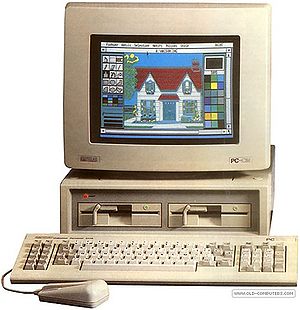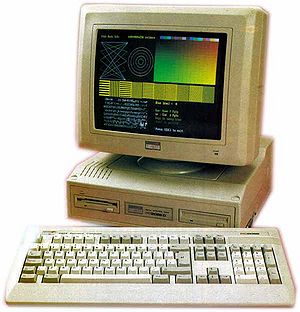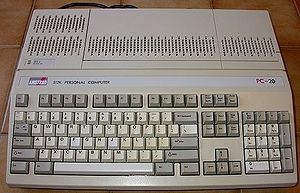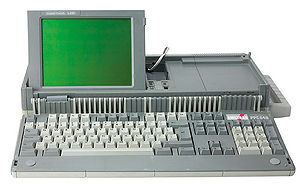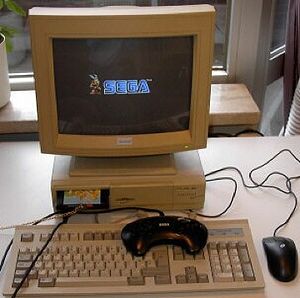Those cheap IBM compatible PCs allowed the professionnal PC standard to enter many houses as a Home computer.
List of Amstrad PCs
- PC1512 (1985) : the first model, what equipped with a custom CGA clone video card, enabling an interesting non standard 640x200x16 video mode.
- PC1640 (1987) : second model, was an "upgraded" PC1512, sharing a lot of pieces. It had +128K Ram (640K) and was supplied with a EGA video card and monitor. Hence it was more exepnsive an EGA standard failed to impose itself.
- PC2086 : a PC with VGA display.
- PC20 : a CGA PC (bad choice) in an Atari ST/Amiga 500 look alike casing. It could have sold well if equipped with a soundchip and an EGA capability.
- Sinclair PC 200 (1988) (same as Amstrad PC20, but with additional TV output and with differently coloured case)
- MegaPC (1993) : A PC featuring a Sega MegaDrive too.
The video displays
The 3 major kind of display from this era had to get specific monitors, and those were quite expensive.
CGA
enabled mostly 320x200 display with a palette of 4 colours choosen between 4 combinaisons (only one colour to be choosen) from 16 total colours. Could also get a text mode with character attribute based 16 colours display.
- Amstrad's custom CGA : was mostly CGA compatible yet not ewactly. It could also get a special custom mode with a 640x200x16 display, the 16 colours being the CGA total palette, hence it could be as good as most badly exploited EGA cards.
- EGA : could display the CGA modes, and an extended CGA mode at 320x200x16 colours, the 16 colours being only the CGA full palette, this is probably the detail which killed the EGA. Otherwise it had its native colour mode of 640x350x16 the palette being set from the 64colours EGA palette (2x2x2 bits), such mode was actually even better than what an Atari ST could do... despite a lesser total palette to choose from, the same amount of colours (16 with no trick) were displayed at a far better resolution too. This 'Real EGA" mode was rarely well exploited for obscure reasons by game developpers who wanted to keep a retro-compatibility with CGA versions.
- VGA : the widely used VGA mode was the MCGA : 320x200x256. When those kind of display were widely available the CGA and EGA were obsolete and the PC could start to kick Amiga and Atari ST standards out of the place. VGA could also display a 640x480x16 video mode. All those from a 262,144colour total palette (6x6x6 bits). The VGA could also display all previous modes from CGA and EGA cards.
